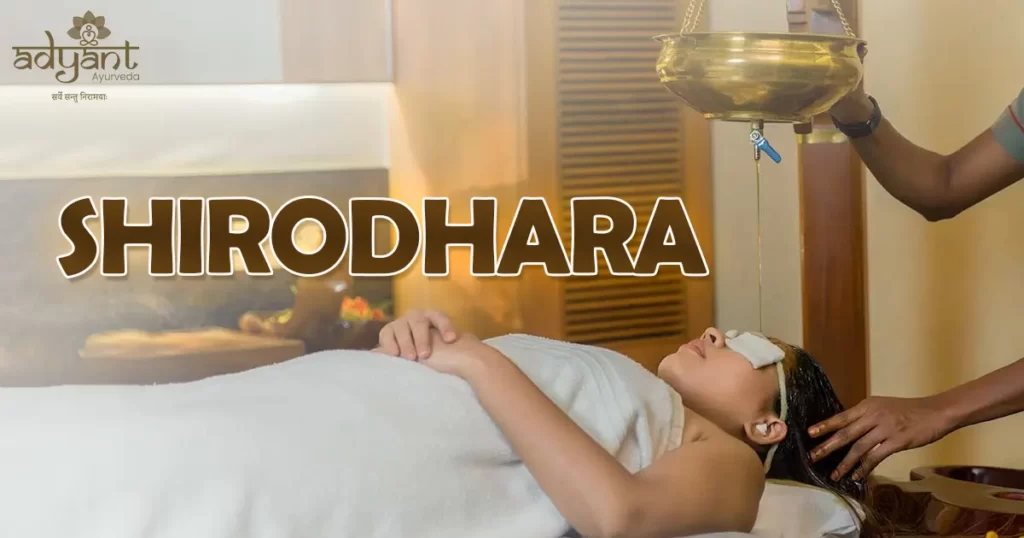Shirodhara is a type of treatment that combines the phrases “Shiro,” which means “head,” and “Dhara is a Sanskrit word that means “flow” or “stream”. In Ayurveda, Dhara is a therapeutic procedure that involves pouring a continuous stream of warm herbal oil, milk, or buttermilk over the forehead or entire body rhythmically and consistently. It is a long-established Best Ayurvedic treatment technique that has been used in India for nearly 5000 years. The nervous system is significantly affected by this medication. It has a calming and relaxing effect on your mind right away and helps to clear your nerves.
Shirodhara is quite helpful for those who have vata and pitta imbalances. When one’s vata is out of balance, it causes feelings of anxiety, insecurity, and concern. Pitta imbalance can make a person furious, impatient, and irritable, and it can even make him forget his sense of right and wrong. Shirodhara uses liquids that work to mitigate the harmful effects of imbalanced doshas or other ailments. When administered to the forehead, scalp, and nervous system, the liquid calms and relaxes the doshas. It has several positive advantages in addition to lowering stress and calming the nervous system.
Types of Shirodhara
Shirodhara aids with stress reduction, insomnia treatment, migraine relief, high blood pressure reduction, hair loss prevention, and even helps with focus and attention. Here are the types of Shirodhara:
The oil or other liquid used in Dhara is selected based on the individual’s Ayurvedic constitution and specific health needs. During the procedure, the liquid is poured from a vessel with a small hole, typically hung from a support above the person’s head. The stream of liquid is directed over the forehead or other specific parts of the body and is often accompanied by gentle massage or other Ayurvedic therapies
- Taila Dhara: This is the most common type of Shirodhara and involves the use of warm herbal oil poured onto the forehead. Taila Dhara is used to help balance the doshas, promote relaxation, and improve overall health and well-being
- Takra Dhara: This type of Shirodhara involves the use of buttermilk instead of oil. Takra Dhara is believed to be particularly effective for skin conditions such as eczema and psoriasis, as well as for improving digestion and promoting relaxation.
- Ksheera Dhara: This type of Shirodhara involves the use of warm milk instead of oil. Ksheera Dhara is believed to be particularly effective for calming the mind and reducing stress and anxiety.
- Jala Dhara: This type of Shirodhara involves the use of warm water instead of oil. Jala Dhara is believed to be particularly effective for treating conditions such as headaches, insomnia, and other nervous system disorders.
- Taila-Jala Dhara: This type of Shirodhara involves the use of both warm oil and warm water. Taila-Jala Dhara is believed to be particularly effective for promoting physical and mental relaxation, as well as for balancing the doshas.
- Kwatha Dhara: This involves the use of herbal decoctions as the liquid is poured onto the forehead.
The type of Shirodhara used will depend on the individual’s specific needs and the practitioner’s recommendation. Each type of Shirodhara has its unique benefits and can be tailored to the individual’s needs.
How is Shirodhara therapy done?
Shirodhara is most effective when performed in the morning or the evening. After a person lies down with his or her eyes closed, shirodhara may start with an abhyangam or other form of Ayurvedic body massage. After that, lukewarm oil is applied to the forehead as part of the treatment. The oil is continually and oscillatory poured in a stream. It is important to take precautions to prevent oil from getting in the ears or eyes. Depending on the patient’s condition, the full process could take 30 to 45 minutes. Before or during the operation, a therapist could also give the patient a brief head massage.
Since the forehead has a lot of nerve endings and is therefore extremely sensitive, oil is applied there. The pressure of the oil causes vibrations to occur on the forehead. After coating the forehead and scalp, the oil enters the nervous system. By dilating all the channels, the oils employed in this technique increase blood flow to the brain. As a result, it offers relief from anxiety and other related problems by lowering the levels of stress hormones including adrenaline and noradrenaline. The entire process allows the body, mind, and nerve system to enter a profound sleep state akin to that experienced after meditating.
Potential benefits of Shirodhara:
1. Reduce Stress and Anxiety: The gentle pressure and warmth of oil on the forehead can calm the nervous system and promote relaxation, reducing feelings of stress and anxiety.
- Promotes better sleep: Shirodhara can help balance the body’s natural sleep rhythms, leading to better quality sleep.
- Improves mental clarity: Shirodhara has been shown to improve concentration, memory, and overall mental clarity.
- Relieves headaches and migraines: The soothing effects of shirodhara can help relieve tension headaches and migraines.
- Balances hormones: Shirodhara can help balance the endocrine system, leading to improved hormonal balance and reduced symptoms of hormonal imbalances.
- Enhances hair and scalp health: The warm oil used in Shirodhara can help nourish the scalp and hair, improving overall hair health and appearance.
Why is Shirodhara fair to your body:
Shirodhara stimulates and massages the pineal gland. Shirodhara induces Autonomous Sensory Meridian Response (ASMR), a euphoric experience characterized by a tingling sensation on the skin that typically starts on the scalp and moves down the back of the neck and upper spine. ASMR causes relaxation and promotes balance and harmony in the body. It works by stimulating the Third Eye Chakra and the Crown Chakra.
All types of psychological and mental disorders can benefit from shirodhara. By promoting relaxation and boosting serotonin release in the brain, it lowers stress. It causes head sensations that travel to the brain via the superficial nerves and promote peace and relaxation. More serotonin is secreted in the brain as a result of this serenity and relaxation, which eases sadness and lowers mental tension.
Does Shirodhara has any negative effects?
Shirodhara is a highly helpful procedure, and there are no significant adverse effects connected with it. However, some people may feel as though their heads are heavy. Some people may feel a little lightheaded, and for those who kept their eyes open throughout the treatment, their odds of feeling queasy may be higher.
What rules apply following treatment?
After receiving this therapy, patients will need to wash the oil out of their hair. It is preferable to shampoo hair first, then wash it with water. This is due to the shampoo’s ability to adhere to the hair and guarantee thorough cleaning. Since caffeine has a detrimental effect on the nervous system, it should be avoided for a few days after the treatment. Warm water should be used for drinking and taking a bath. Additionally, one should follow a light diet and stay away from fatty foods.
In the end, Shirodhara is undoubtedly one of the best Ayurvedic Treatments for promoting physical and mental wellness. Its numerous benefits include stress relief, improved sleep quality, enhanced mental clarity, headache and migraine relief, hormonal balance, and improved skin and hair health. As an Ayurvedic Hair Loss Treatment, shirodhara can help nourish the scalp and improve hair growth, leading to thicker, healthier hair. Overall, Shirodhara is a holistic therapy that can provide a wide range of benefits, making it a great Ayurveda Hair Treatment to consider for those looking to improve their overall well-being. So why not give Shirodhara a try and experience the rejuvenating effects of this ancient Ayurvedic therapy for yourself?





